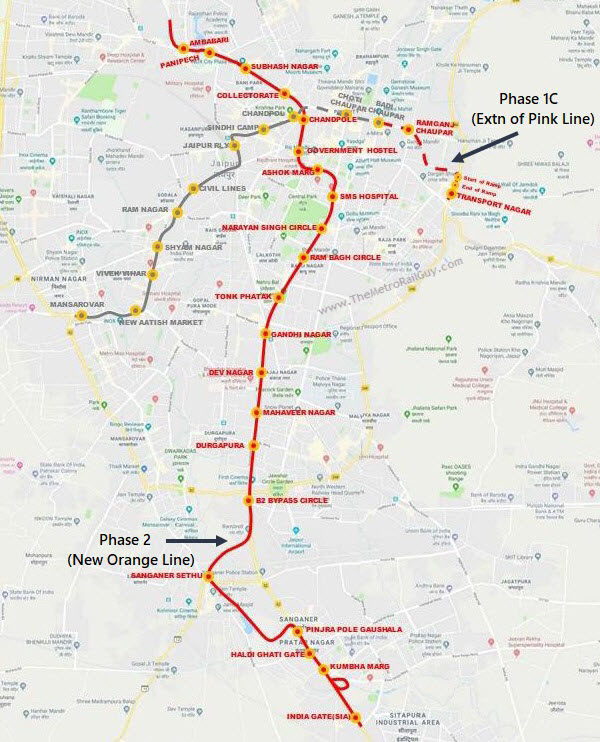Jaipur Metro Publishes Phase 1C & Phase 2 DPRs for Finalization
Jaipur Metro Rail Corporation (JMRC) through the Government of Rajasthan has published a notice seeking suggestions on the city’s new 2.85 km Phase 1C (Badi Chaupar to Transport Nagar) and revised 23.51 km Phase 2 (India Gate to Ambabari) projects.
The preparation for both projects’ DPRs was assigned to the Delhi Metro Rail Corporation (DMRC) on June 20 2019, and suggestions on improving them must be submitted by February 28 to jaipurmetrophase2 at gmail. It’s odd that they’re using gmail, but anyhow inputs from this exercise will help draft the final DPR, which will be sent to the state government for approval.
Jaipur Metro Phase 1C
This brand new phase will extend Jaipur’s operational 11.98 km Pink Line (Mansaravor – Badi Chaupar) eastward to Transport Nagar by 2.85 km of which 2.26 km will be underground through the old city with 1 station at Ramganj Chaupar, and 0.59 km will be elevated with 1 station at Transport Nagar.
Phase 1C’s DPR was prepared by the Delhi Metro Rail Corporation (DMRC) in June 2020 and can be viewed here. It’s estimated to cost Rs. 856 crore including taxes and land cost if construction starts in April 2021 and the project is completed by November 2023.
This timeline of course cannot be achieved and a more accurate figure will emerge only after the project is approved by the state and central governments’ cabinets, either of which I don’t see happening in 2021.
DMRC recommends no additional trains (rolling stock) will be required for this small extension as the existing 10 4-car BEML train-sets will be sufficient.

Jaipur Metro Phase 2
Phase 2’s original DPR was prepared in March 2010, revised in April 2011, April 2014 and July 2014. In June 2017, a consortium of Egis Rail – Feedback Infra was appointed to revise it once again, but their contract was terminated in 2018 which led to a legal battle. They had estimated Phase 2 to cost approximately Rs. 9500 crore.
In its most recent form (view DPR), Phase 2’s 23.51 km Orange Line will now be entirely elevated with 21 stations connecting India Gate (Sitapur Industrial Area) to Ambabari. By eliminating the underground section through the old city, which is horrible in my opinion, the cost has been brought down to Rs. 4546 crore.
Stations are planned at Ambabari, Pani Petch, Subash Nagar, Collectorate, Chandpole (interchange), Government Hostel, Ashok Marg, SMS Hospital, Narayan Singh Circle, Ram Bagh Circle, Tonk Phatak, Gandhi Nagar Raiway Station, Dev Nagar, Mahaveer Nagar, Durgapura, B2 Bypass, Sanganer Sethu, Pinjarapole Gaushala, Haldi Ghati Gate, Kumbha Marg and India Gate.
Two things to call out – instead of Sindhi Camp, Chandpole Station is now recommended to serve as an interchange between the pink and orange lines. At the southern end, the line is now shown to make a big semi-circle detour towards Sanganer Sethu, presumably to allow for a greater height clearance from flights coming in to land at Jaipur Airport’s 09/27 runway.
DMRC recommends using 2.90 m wide trains (rolling stock) with a stabling / maintenance depot at Sitapur Industrial Area on a 27 hectare land parcel. The rake requirements lists that a total of 15 3-car trains will be sufficient to operate in 2031 with a headway of 7 minutes. Trains must be compliant to run “driverless” on the UTO (unattended train operation) mode.
For signaling, they recommend using CBTC (Communication based Train Control System). On the construction side, segment box girders are recommended for use on roads with a width of 30m, U-girders for other roads and I-girders for sharp curves.
Concluding Thoughts
The last few pages of Phase 2’s DPR has a nice table with JMRC’s concerns and the DMRC’s response and subsequent actions – so it’s good to see the client (JMRC) examining what’s presented with a fine-tooth comb.
I do think they’re missing a trick by skipping the airport which is en route. An underground detour would have been ideal. The issue I see among planners almost all over India – and the revision of Phase 2’s DPR is a good example – is that they fixate too much on reducing cost, rather than focusing on long-term and convenient passenger-friendly multi-modal connections.
An approximately 2 km underground section with 1 station will cost no more than Rs. 400 crore, which in the grand scheme of things is nothing. I will be sending this as a recommendation to the email address listed above – I hope people reading this do too!
For more updates on India’s metro systems, check out my Home Page!
– TMRG
Hat tip: Aabhash Agrawal




Bangalore – constructing ~60km new metro line to connect to airport.
Jaipur – taking a detour to not connect to airport.
I don’t understand these planners.
That’s not entirely correct. Of the 56km blue line, only the 16km section north of Bagalur cross station is to connect airport out of which 5km is off the highway along the detour road to airport (past the trumpet interchange).
The remaining 40km (up to Bagalur cross station) is actually on already well developed areas that anyway need metro, even as of now. Out of the 16km length from Bagalur cross to the airport, 11km up to Doddajala is also developing fast and will probably need a metro anyway by 2028-30.
They can save Rs. 4546 crore by not building the line altogether 🤷♂️
If you are not aware, phase 2 is planned to run on the busiest part of jaipur. And it is in absolute need to run an alternate public transport besides buses, which are crawling in the crowdiest streets in jaipur
It must be extended on ambabari part as it will not give much passengers, it should be extended to murlipura or VKI it will be the best route
Hey, TMRG one correction.
CATC is not based on CBTC, rather than it is the predecessor of CBTC, old technology which is installed in all lines of Delhi Metro except 7,8 and 9, based upon AF frequency based Track Circuits. Although cheaper in comparison, but it is very much maintenance intensive. Wonder how they plan to run UTO modes on this network, given the technology is very old.
That’s a direct phrase from Page 2 – found it odd. I’ve now rephrased it to simply CBTC.